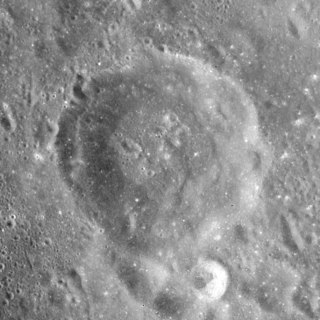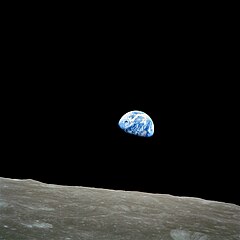
Censorinus is a 3.8 km lunar impact crater located on a rise to the southeast of the Mare Tranquillitatis. It is named after the ancient Roman writer Censorinus. To the northeast is the crater Maskelyne.

Anders is a worn lunar impact crater that is located in the southern hemisphere on the far side of the Moon. It lies just to the southeast of the outer rim of the huge walled basin named Apollo. To the south-southeast is the crater Leavitt.

Humboldt is a large lunar impact crater that is located near the eastern limb of the Moon. Due to foreshortening this formation has an extremely oblong appearance. The actual shape of the crater is an irregular circle, with a significant indentation along the southeastern rim where the prominent crater Barnard intrudes. To the north-northwest of Humboldt is the large crater Hecataeus. Phillips is attached to the western rim. The rim of Humboldt is low, worn, and irregular in outline. The central peak forms a range on the crater floor. The floor surface contains a network of rilles forming a pattern of radial spokes and concentric arcs. There are also some dark patches located near the walls to the northeast, northwest, and southeast. There is a chain of craters leading from the northwest crater rim to a distance almost as long as the crater is wide. This formation is designated Catena Humboldt. Due to its location near the lunar limb, little detail was known about this crater until it was photographed by orbiting spacecraft.

Cauchy is a small lunar impact crater on the eastern Mare Tranquillitatis. It was named after French mathematician Augustin-Louis Cauchy. It is circular and symmetric, with a small interior floor at the midpoint of the sloping inner walls. Due to the high albedo of this bowl-shaped formation, it is particularly prominent at full Moon.

Furnerius is a large lunar impact crater located in the southeast part of the Moon, in the area close to the southeastern limb of the nearside or visible Moon. Because of its location, the crater appears oval in shape due to foreshortening but is actually nearly circular. Notable nearby craters include Stevinus to the northwest and Fraunhofer to the south-southwest. Farther to the northwest is the crater Snellius and the Vallis Snellius crater valley.

Apollo, also called the Apollo basin, is an enormous impact crater located in the southern hemisphere on the far side of the Moon. This formation dwarfs the large crater Oppenheimer that is located next to the western rim. The crater Barringer lies across the northern wall. To the southeast is the crater Anders, and Kleymenov is just to the east of the rim.

Borman is a lunar impact crater that is located in the southern hemisphere on the far side of the Moon. It lies across the southeast section of the mountainous inner ring, within the walled basin named Apollo.

de Gerlache is a lunar impact crater that is located along the southern limb of the Moon, within a crater diameter of Shackleton at the south pole. From the Earth this crater is seen from the edge, and it lies in perpetual darkness. Thus little or no detail can be seen of this crater, other than the edge of the rim. However, the crater is clearly visible in Earth-based radar images. The crater is roughly circular, with some slight wear. No craters of note overlie the rim, although some formations may be attached to the southern and western edges.

Cusanus is a lunar impact crater that is located near the northeastern limb of the Moon. In this location the crater appears very foreshortened when observed from the Earth, and its visibility is affected by libration. The northern rim of Cusanus is nearly joined to the south-southeastern rim of the larger crater Petermann. To the west is Baillaud and to the southeast is Hayn.

Dollond is a small lunar impact crater that is located in the central region of the Moon, to the north of the crater Abulfeda. It was named after British optician John Dollond. Due west of Dollond is Anděl. Dollond is circular and cone shaped, with a tiny floor at the midpoint of the sloping interior walls.

Pasteur is a large lunar impact crater, approximately 233 kilometers in diameter, belonging to the category termed a walled plain. It was named after French chemist and microbiologist Louis Pasteur. It lies on the far side of the Moon as seen from the Earth, just beyond the eastern limb. The vicinity of this crater is occasionally brought into view from Earth due to librations, although not much detail can be seen.

Mons Hadley is a massif in the northern portion of the Montes Apenninus, a range in the northern hemisphere of the Moon. It has a height of 4.5 km (2.8 mi) 14,764 ft (4,500 m) above the adjacent plain and a maximum diameter of 25 km at the base.

Ganskiy is a lunar impact crater that is located on the far side of the Moon. It lies to the southeast of the walled plain Hirayama.

Ludwig is a small lunar impact crater that is located just beyond the eastern limb of the Moon, placing it on the far side from the Earth. It lies just to the east of the much larger crater Hirayama, and to the north of Ganskiy.

Earthrise is a photograph of Earth and part of the Moon's surface that was taken from lunar orbit by astronaut William Anders on December 24, 1968, during the Apollo 8 mission. Nature photographer Galen Rowell described it as "the most influential environmental photograph ever taken".

Selenography is the study of the surface and physical features of the Moon. Like geography and areography, selenography is a subdiscipline within the field of planetary science. Historically, the principal concern of selenographists was the mapping and naming of the lunar terrane identifying maria, craters, mountain ranges, and other various features. This task was largely finished when high resolution images of the near and far sides of the Moon were obtained by orbiting spacecraft during the early space era. Nevertheless, some regions of the Moon remain poorly imaged and the exact locations of many features are uncertain by several kilometers. Today, selenography is considered to be a subdiscipline of selenology, which itself is most often referred to as simply "lunar science." The word selenography is derived from the Greek word Σελήνη and γράφω graphō, meaning to write.

Rupes Cauchy is a 120 km-long escarpment at 9.0°N 37.0°E on the surface of the Moon. It faces southwest, and rises about 200–300 m. It is located in the northeastern portion of the Mare Tranquillitatis, and is named after the nearby crater Cauchy.

Anders' Earthrise is a lunar impact crater that is located on the southern hemisphere on the far side of the Moon. It is visible in the foreground of the famous Earthrise photograph (AS08-14-2383) taken by astronaut William Anders on the Apollo 8 mission to the Moon in 1968. The crater's name was approved by the IAU on 5 October 2018. The crater 8 Homeward, also visible in the Earthrise photograph, was named at the same time.



















